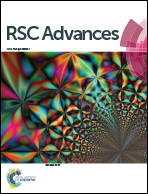Au-loaded porous graphitic C3N4/graphene layered composite as a ternary plasmonic photocatalyst and its visible-light photocatalytic performance
Abstract
A novel ternary plasmonic photocatalyst, Au-loaded porous graphitic C3N4/graphene layered composite (Au/pg-C3N4/GR), was fabricated by a facile sonication-photodeposition technique. In this hybrid structure, a polymeric semiconductor pg-C3N4 was immobilized on the surfaces of graphene sheets to form a layered composite with Au nanoparticles of sizes 10–15 nm uniformly deposited on it. The photocatalytic performance of the as-prepared Au/pg-C3N4/GR composite was evaluated by degradation of methylene blue (MB) and ciprofloxacin (CIP) as representative dye pollutant and antibiotic pollutant under visible light irradiation, respectively. The degradation rates of MB and CIP over the Au/pg-C3N4/GR photocatalyst were 4.34 and 3.05 times higher that of porous g-C3N4 (pg-C3N4), respectively, and even 7.42 and 6.09 times higher than that of pure g-C3N4, respectively. The results indicated that an improved photocatalytic efficiency was obtained when Au nanoparticles and graphene sheets co-incorporated in porous g-C3N4. The porous structure within the samples is advantageous to the adsorption capacity. The surface plasmon resonance (SPR) effect of Au and electron-acceptor role of graphene, which would improve the visible light harvesting ability, facilitate photogenerated charge carrier separation, as well as create more active reaction sites, and synergistically contribute to the enhancement of photocatalytic activity. Moreover, a possible photocatalytic mechanism was also tentatively proposed.


 Please wait while we load your content...
Please wait while we load your content...